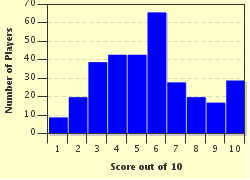Quiz Answer Key and Fun Facts
1. Long has there been disconnect between the Lower and Upper Peninsulas of Michigan. In 1858, 1897, and 1962, strong pushes were made to make the Upper Peninsula its own state, despite the fact it would be the least populated state by far. What was this failed state, which would still share its name with a Great Lake, to be called?
2. Stating a bid to secede from North Carolina in 1784, this area of present-day Tennessee earned seven of nine required votes to become a state in 1785, failing to be admitted as the fourteenth state in the Union. Its name was changed in order to gain support from a founding father and shares a name with a city in present-day Tennessee, although they are not in the same region. What was this state to be named?
3. When the United States annexed Texas in 1845, a resolution was passed that the state could be divided into no more than four separate states. The first time Texas was close to being divided was 1869, when Congress proposed splitting the state using the Colorado River as a border, and naming it after a recently-deceased president. What was this southwestern portion of Texas to be called?
4. In 1939, some citizens of the northwest US believed their government did not speak for them. In response, they got together and attempted to create Absaroka, named after a nearby mountain range. With the capital at the city of Sheridan, what real states did new territory plan to draw land from?
5. Before the American Revolution kicked off, settlers in the western Virginia and Pennsylvania regions (mostly in modern-day West Virginia) felt too separated from their colonies' governments. Following the feeling of independence at the time, they banded together to petition Congress during late 1776, when Congress was weary to alienate any colonial governments. What name, seemingly an amalgamation of part of two modern states' names, was it to have?
6. Three times in the course of American history have states been proposed with the name "Jefferson." Failed attempts in Texas and Colorado left the name available for use in the Northwest, and several counties in Oregon and California tried to use it 115 years after Thomas Jefferson's death. Unfortunately, the newly-elected governor died after days in office and then conflict broke out. What war interrupted the secession movement?
7. Against its own state's wishes, Scott County voted 541-19 against the decision to secede from the Union in 1861, led by future president Andrew Johnson. When the state did anyway, they created the Independent State of Scott, which functioned as an enclave state during the war despite never being recognized by any government. Scott did not repeal its decision until 1986, when it was ceremonially accepted back by what state?
8. In 1900, Native Americans in the Indian Territory (eastern present-day Oklahoma) accounted for only 13.4% of the population, and that went down to 10% in 1905. In order to maintain what little territory they had, the Five Civilized Tribes in the Indian Territory drafted a constitution and petitioned Congress for statehood in 1905, to be named after the man who created the Cherokee writing system. What would the name have been?
9. In 1861, the counties of what would eventually become West Virginia seceded from Virginia when the latter state seceded from the Union. With its capital at Wheeling, they chose the name Kanawha before later choosing the modern name that would go into effect in 1863, in order to keep the feeling of their Virginian legacy. What was the name Kanawha taken from?
10. Following the Mexican-American War, three regions in the West attempted to apply for statehood. California's bid succeeded in 1850, while New Mexico would have to wait 63 years. Meanwhile in 1849, Deseret hurriedly applied for statehood to beat the other two. Unfortunately, President Zachary Taylor rejected it to maintain the delicate balance in the Senate between free and slave states. What group of people wanted to create Deseret?
Source: Author
illiniman14
This quiz was reviewed by FunTrivia editor
bloomsby before going online.
Any errors found in FunTrivia content are routinely corrected through our feedback system.

